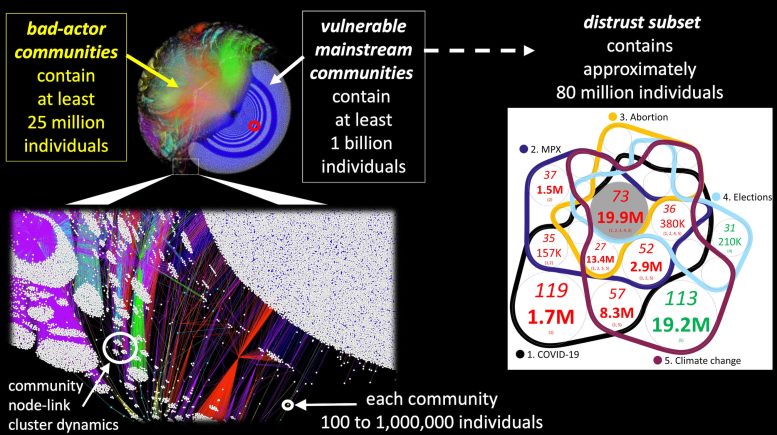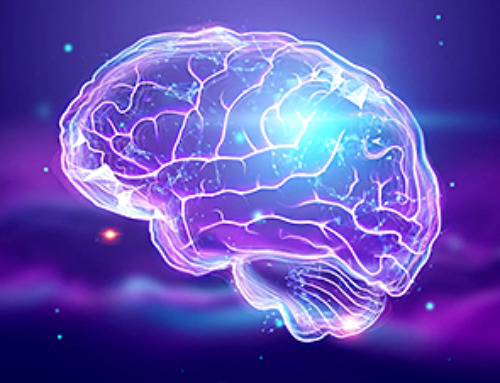A study forecasts that by mid-2024, bad actors are expected to increasingly utilize AI in their daily activities. The research, conducted by Neil F. Johnson and his team, involves an exploration of online communities associated with hatred. Their methodology includes searching for terminology listed in the Anti-Defamation League Hate Symbols Database, as well as identifying groups flagged by the Southern Poverty Law Center.
From an initial list of “bad-actor” communities found using these terms, the authors assess communities linked to by the bad-actor communities. The authors repeat this procedure to generate a network map of bad-actor communities—and the more mainstream online groups they link to.
Mainstream Communities Categorized as “Distrust Subset”
Some mainstream communities are categorized as belonging to a “distrust subset” if they host significant discussion of COVID-19, MPX, abortion, elections, or climate change. Using the resulting map of the current online bad-actor “battlefield,” which includes more than 1 billion individuals, the authors project how AI may be used by these bad actors.
The bad-actor–vulnerable-mainstream ecosystem (left panel). It comprises interlinked bad-actor communities (colored nodes) and vulnerable mainstream communities (white nodes, which are communities to which bad-actor communities have formed a direct link). This empirical network is shown using the ForceAtlas2 layout algorithm, which is spontaneous, hence sets of communities (nodes) appear closer together when they share more links. Different colors correspond to different platforms. Small red ring shows 2023 Texas shooter’s YouTube community as illustration. Right panel shows Venn diagram of the topics discussed within the distrust subset. Each circle denotes a category of communities that discuss a specific set of topics, listed at bottom. The medium size number is the number of communities discussing that specific set of topics, and the largest number is the corresponding number of individuals, e.g. gray circle shows that 19.9M individuals (73 communities) discuss all 5 topics. Number is red if a majority are anti-vaccination; green if majority is neutral on vaccines. Only regions with > 3% of total communities are labeled. Anti-vaccination dominates. Overall, this figure shows how bad-actor-AI could quickly achieve global reach and could also grow rapidly by drawing in communities with existing distrust. Credit: Johnson et al.
The authors predict that bad actors will increasingly use AI to continuously push toxic content onto mainstream communities using early iterations of AI tools, as these programs have fewer filters designed to prevent their usage by bad actors and are freely available programs small enough to fit on a laptop.
AI-Powered Attacks Almost Daily by Mid-2024
The authors predict that such bad-actor-AI attacks will occur almost daily by mid-2024—in time to affect U.S. and other global elections. The authors emphasize that as AI is still new, their predictions are necessarily speculative, but hope that their work will nevertheless serve as a starting point for policy discussions about managing the threats of bad-actor-AI.
Reference: “Controlling bad-actor-artificial intelligence activity at scale across online battlefields” by Neil F Johnson, Richard Sear and Lucia Illari, 23 January 2024, PNAS Nexus.
DOI: 10.1093/pnasnexus/pgae004
News
New Once-a-Week Shot Promises Life-Changing Relief for Parkinson’s Patients
A once-a-week shot from Australian scientists could spare people with Parkinson’s the grind of taking pills several times a day. The tiny, biodegradable gel sits under the skin and releases steady doses of two [...]
Weekly injectable drug offers hope for Parkinson’s patients
A new weekly injectable drug could transform the lives of more than eight million people living with Parkinson's disease, potentially replacing the need for multiple daily tablets. Scientists from the University of South Australia [...]
Most Plastic in the Ocean Is Invisible—And Deadly
Nanoplastics—particles smaller than a human hair—can pass through cell walls and enter the food web. New research suggest 27 million metric tons of nanoplastics are spread across just the top layer of the North [...]
Repurposed drugs could calm the immune system’s response to nanomedicine
An international study led by researchers at the University of Colorado Anschutz Medical Campus has identified a promising strategy to enhance the safety of nanomedicines, advanced therapies often used in cancer and vaccine treatments, [...]
Nano-Enhanced Hydrogel Strategies for Cartilage Repair
A recent article in Engineering describes the development of a protein-based nanocomposite hydrogel designed to deliver two therapeutic agents—dexamethasone (Dex) and kartogenin (KGN)—to support cartilage repair. The hydrogel is engineered to modulate immune responses and promote [...]
New Cancer Drug Blocks Tumors Without Debilitating Side Effects
A new drug targets RAS-PI3Kα pathways without harmful side effects. It was developed using high-performance computing and AI. A new cancer drug candidate, developed through a collaboration between Lawrence Livermore National Laboratory (LLNL), BridgeBio Oncology [...]
Scientists Are Pretty Close to Replicating the First Thing That Ever Lived
For 400 million years, a leading hypothesis claims, Earth was an “RNA World,” meaning that life must’ve first replicated from RNA before the arrival of proteins and DNA. Unfortunately, scientists have failed to find [...]
Why ‘Peniaphobia’ Is Exploding Among Young People (And Why We Should Be Concerned)
An insidious illness is taking hold among a growing proportion of young people. Little known to the general public, peniaphobia—the fear of becoming poor—is gaining ground among teens and young adults. Discover the causes [...]
Team finds flawed data in recent study relevant to coronavirus antiviral development
The COVID pandemic illustrated how urgently we need antiviral medications capable of treating coronavirus infections. To aid this effort, researchers quickly homed in on part of SARS-CoV-2's molecular structure known as the NiRAN domain—an [...]
Drug-Coated Neural Implants Reduce Immune Rejection
Summary: A new study shows that coating neural prosthetic implants with the anti-inflammatory drug dexamethasone helps reduce the body’s immune response and scar tissue formation. This strategy enhances the long-term performance and stability of electrodes [...]
Scientists discover cancer-fighting bacteria that ‘soak up’ forever chemicals in the body
A family of healthy bacteria may help 'soak up' toxic forever chemicals in the body, warding off their cancerous effects. Forever chemicals, also known as PFAS (per- and polyfluoroalkyl substances), are toxic chemicals that [...]
Johns Hopkins Researchers Uncover a New Way To Kill Cancer Cells
A new study reveals that blocking ribosomal RNA production rewires cancer cell behavior and could help treat genetically unstable tumors. Researchers at the Johns Hopkins Kimmel Cancer Center and the Department of Radiation Oncology and Molecular [...]
AI matches doctors in mapping lung tumors for radiation therapy
In radiation therapy, precision can save lives. Oncologists must carefully map the size and location of a tumor before delivering high-dose radiation to destroy cancer cells while sparing healthy tissue. But this process, called [...]
Scientists Finally “See” Key Protein That Controls Inflammation
Researchers used advanced microscopy to uncover important protein structures. For the first time, two important protein structures in the human body are being visualized, thanks in part to cutting-edge technology at the University of [...]
AI tool detects 9 types of dementia from a single brain scan
Mayo Clinic researchers have developed a new artificial intelligence (AI) tool that helps clinicians identify brain activity patterns linked to nine types of dementia, including Alzheimer's disease, using a single, widely available scan—a transformative [...]
Is plastic packaging putting more than just food on your plate?
New research reveals that common food packaging and utensils can shed microscopic plastics into our food, prompting urgent calls for stricter testing and updated regulations to protect public health. Beyond microplastics: The analysis intentionally [...]






















